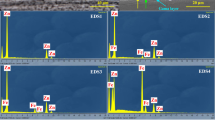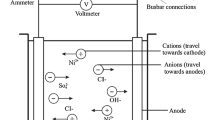Zn–Ni coatings were deposited under galvanostatic conditions at current densities varying within the range 20– 60 mA ⋅ cm–2. The influence of the current density of deposition on the surface morphology, chemical and phase compositions, and corrosion resistance was investigated. Structural investigations were performed by the X-ray diffraction (XRD) method. The surface morphology and chemical composition of deposited coatings were studied by using a JEOL JSM-6480 scanning electron microscope. The studies of general electrochemical corrosion resistance were carried out in a 5% NaCl solution by using potentiodynamic and electrochemical impedance spectroscopy (EIS) methods. The local corrosion resistance was determined by the Scanning Kelvin Probe (SKP) method. On the basis of the research, the possibility of deposition of Zn–Ni coatings containing 14–18 at.% Ni was demonstrated. It was stated that the surface morphology, as well as the chemical and phase compositions of these coatings depend, to a small extent, on the current density of deposition. However, current density of deposition determines the quantity of zinc which is codeposited with nickel and is bounded in the form of an inter-metallic compound or a solid solution. Small differences between the chemical composition and the uneven distribution of the Zn(Ni) and Ni2Zn11 phases on the surfaces of the coatings may cause differences in the local Kelvin potential. As a result, the Zn–Ni coatings exhibit corrosion resistances varying depending on the current density of deposition. The optimal values of the current density from the viewpoint of corrosion resistance were found to be j = 30–40 mA ⋅ cm–2.









Similar content being viewed by others
References
S. S. Abd El Rehim, E. E. Fouad, S. M. Abd El Wahab, and H. H. Hassan, “Electroplating of zinc–nickel binary alloys from acetate baths,” Electrochem. Acta, 41, No. 9, 1413–1418 (1996).
R. Fratesi and G. Roventi, “Corrosion resistance of Zn–Ni alloy coatings in industrial production,” Surf. Coat. Technol., 82, 158– 164 (1996).
J. B. Bajat, V. B. Mišković-Stankovic, M. D. Maksimović et al., “Electrochemical deposition and characterization of Zn–Co alloys and corrosion protection by electrodeposited epoxy coating on Zn–Co alloy,” Electrochem. Acta, 47, 4101–4112 (2002).
P. Ganesan, S. P. Kumaraguru, and B. N. Popov, “Development of compositionally modulated multiplayer Zn–Ni deposits as replacement for cadmium,” Surf. Coat. Technol., 201, 7896–7904 (2007).
J. B. Bajat, Z. Kačarević-Popović, V. B. Mišković-Stankowić, and M. D. Maksimowić, “Corrosion behavior of epoxy coatings electrodeposited on galvanized steel and steel modified by Zn–Ni alloys,” Progr. Org. Coat., 39, 127–135 (2000).
M. Gavrila, J. P. Millet, H. Mazille, et al., “Corrosion behavior of zinc-nickel coatings electrodeposited on steel,” Surf. Coat. Technol., 123, 164–172 (2000).
P. Ganesan, S. P. Kumaraguru, and B. N. Popov, “Development of compositionally modulated multilayer Zn–Ni deposits as replacement for cadmium,” Surf. Coat. Technol., 201, 7896–7904 (2007).
A. Petrauskas, L. Grinceviciene, A. Cesuniene, and E. Matulionis, “Stripping of Zn–Ni alloys deposited in acetate-chloride electrolyte under potentiodynamic and galvanostatic conditions,” Surf. Coat. Technol., 192, No. 2–3, 299–304 (2005).
F. Elkhatabi, M. Benballa, M. Sarret, and C. Muller, “Dependence of coating characteristics on the deposition potential for electrodeposited Zn–Ni alloys,” Electrochem. Acta, 44, No. 10, 1645–1653 (1999).
M. E. Soares, C. A. Souza, and C. S. E. Kuri, “Corrosion resistance of a Zn–Ni electrodeposited alloy obtained with a controlled electrolyte flow and gelatin additive,” Surf. Coat. Techn., 201, No. 6, 2953–2959 (2006).
R. Karimi-Shervedani and A. Lasia, “Kinetics of hydrogen evolution reaction on nickel-zinc-phosphorus electrodes,” J. Electrochem. Soc., 144, No. 8, 2652–2657 (1997).
R. Karimi-Shervedani and A. Lasia, “Study of the hydrogen evolution reaction on Ni–Mo–P electrodes in alkaline solutions,” J. Electrochem. Soc., 145, No. 7, 2219–2225 (1998).
Acknowledgement
The present research was financed by the PBZ-MNiSW-4/01/1/2007 Project.
Author information
Authors and Affiliations
Corresponding author
Additional information
Published in Fizyko-Khimichna Mekhanika Materialiv, Vol.47, No.6, pp.107–114, November–December, 2011.
Rights and permissions
About this article
Cite this article
Wykpis, K., Popczyk, M., Niedbała, J. et al. Influence of the Current Density of Deposition on the Properties of Zn–Ni Coatings. Mater Sci 47, 838–847 (2012). https://doi.org/10.1007/s11003-012-9463-4
Received:
Published:
Issue Date:
DOI: https://doi.org/10.1007/s11003-012-9463-4




